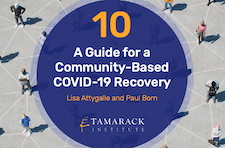Discover financial empowerment resources
Discover financial empowerment resources
Our cities and communities are where people live. It is here we see the effects of public policy and it is here where we will address the issues that matter most to Canadians. The choices made today will impact Canada’s recovery from COVID-19. If we want a future where our cities are thriving, we...

This is an infographic on the Adaptive Prosperity framework developed by the Indiana Association for Community Economic Development. This is a collaborative vision of empowerment and assets focused on all parts of a...
For the past 15 years, I have had the privilege of working at the Tamarack Institute, where we observe, document, and teach collective action to individuals and communities seeking to improve their social and economic conditions. We have landed on five core ideas to explain and teach this community...
This article is about evolving frameworks for collective impact. CI is now a permanent – even dominant – part of the landscape of community change. We believe that it’s time for an evolution in the revolution. First, there has been enough experimentation with CI, by diverse communities...
The rise of economic inequality has become a staple of policy debates and stump speeches. Less visible is the way the rise has altered the landscape of America’s urban neighborhoods. Two books should help change that. Matthew Desmond, an urban sociologist at Harvard, has delivered a jolt with...
Strategies for Transformative Scale. In their quest for answers, pioneers such as Year Up and the organizations that follow are experimenting with ways to help far more people while keeping a lid on the growth of their own organizations. Reviewing their efforts to date, we can identify nine...
Is Collective Impact merely a re-branding of collaborative approaches that have been used for years, or does this model provide new insights and techniques that will in fact break through on some of the most intractable problems affecting western societies? In this special issue of The...
As we hurtle towards a human community of 9.7 billion people by the year 2050, coupled with new technologies and the growing challenges of our planet’s carrying capacity, there is more and more discussion of systems and how they change or are created. The post-war era has witnessed an...
The Networked Change Report maps out the strategies and practices that made today’s most successful advocacy campaigns work, while so many others failed to create lasting change on the issues they address. We started by identifying advocacy campaigns over the last ten years that achieved...
Social entrepreneurs are successfully mobilizing both the human and financial capital required to start and scale their social ventures. At MaRS Discovery District (MaRS), we see tremendous momentum building around these new opportunities. However, unless there is a clear understanding by funders...
System mapping is a process often cited in social change literature as an effective way to infuse systems thinking into strategy development and evaluation efforts. However, there is a dearth of practical “how to” guides to help stakeholders apply the principles of systems thinking to their...
The purpose of ths brief is to recommend evaluation strategies that can efficiently build a body of social programs, practices, and strategies (“interventions”) backed by credible evidence of effectiveness. The target audience is Government agencies, philanthropic foundations, and other...
